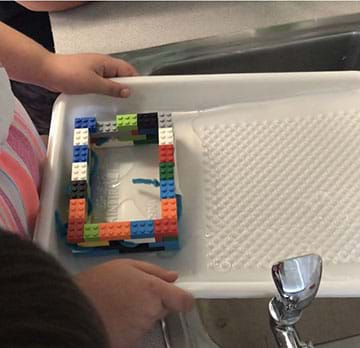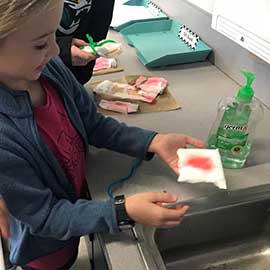Quick Look
Grade Level: Elementary school
Time Required: 2 hours 15 minutes (wild guess!)
(three 45-minute class periods)
Subject Areas: Physical Science, Problem Solving

Maker Challenge Recap
Students employ the engineering design process to create a device that uses water-absorbing crystals for use during a flood or storm surge. Students first spend time making notes on a teacher-led observation of how water-absorbing crystals. Later, they use (or build) a toy house, follow the engineering design process to build their device, and subject the house to tests that mimic a heavy flood or rising tides. After testing, students can iterate on their designs or reflect on what they learned.
Maker Materials & Supplies
- bag of water-absorbing crystals; available at home improvement stores or online (See Resources below)
- dollhouse or other small plastic house, either premade or built with building blocks
- water source (faucet or hose preferred)
- masking tape (or other adhesives)
- scissors
- a variety of construction materials such as cardboard, plastic wrap, foil, plastic bottles, etc.
- eyedropper
- paint tray (optional)
- pipe cleaners
- lab notebooks, pens, or pencils
Worksheets and Attachments
Visit [www.teachengineering.org/makerchallenges/view/uof-2495-inundation-inspiration-design-challenge] to print or download.Subscribe
Get the inside scoop on all things TeachEngineering such as new site features, curriculum updates, video releases, and more by signing up for our newsletter!More Curriculum Like This

In this maker challenge, students follow the engineering design process and use water-absorbing crystals to create a bandage that can be used in a traumatic situation, like a car accident or hiking accident.

Students investigate how different riparian ground covers, such as grass or pavement, affect river flooding. They learn about permeable and impermeable materials through the measurement how much water is absorbed by several different household materials in a model river. Students use what they learn...
Kickoff
Water-absorbing crystals are polymers that, when exposed to water, form hydrogels. A hydrogel is a natural or synthetic polymer that can absorb many times its weight in water. Hydrogels have many practical applications, such as use in contact lenses and diapers. In agricultural applications, hydrogels added to soils allow for larger and more efficient crop yields that use less water.
With the Students
Water-absorbing crystal observation protocol:
Have students observe the water-absorbing crystals prior to beginning this activity. See below for an example of the protocol:
- Each student should have a workstation with a paper towel, an eyedropper, a small cup of water, and a water-absorbing crystal.
- Ask the students to observe the water-absorbing crystal and have students write or draw what they see in their lab books.
- Instruct students to drop a small amount water onto the crystal with the eyedropper until they notice a change. The water crystal will absorb water and become soft and squishy. Again, ask the students to describe what they see in their lab notebooks.
- Next, have the students place their entire water-absorbing crystal into the cup of water so that it is completely submerged. Ask students for their predictions as to what will happen to the size, texture, or shape of the crystal after it soaks in the water for 10 minutes.
- After 10 minutes, have students take the crystal out of the cup. Ask them to describe their observations in their notebooks.
Floodtown, USA is a city directly on Floodplain River. In the rainy summer months, the river can rise, causing flash flooding! The Deluge family’s house has flooded twice in the last year, causing damage to their carpets, floors, and walls. The Deluge family would rather not have the floor repair company on speed dial anymore. Can you use the engineering design process to prototype a device for the Deluges so they can instantly stop floodwaters from ruining their house again?
Resources
- Refer to the Engineering Design Process hub on TeachEngineering to guide your students through the challenge. Utilize the Engineering Design Process Notebook for design process documentation.
- Steve Spangler Science sells a kit with water-absorbing crystals. While this is not necessary to completion of this activity, the website has helpful tips and videos for working with hydrogels.
- Flood by Alvaro F. Villa is a wordless picture book that shows the impacts of a flood on a home.
Maker Time
Have students reflect on their observations from the water-absorbing crystal test protocol. Next, give students the materials and instruct them to create a structure that will stop a flood. Let them know that the water will enter the home at one entry point and that their device should attempt to prevent flooding at that point. Students should also adhere to the following constraints:
- The device must be one piece.
- It should be able to be placed by one person.
- It must be made within a budget of $10 or less; see a sample budget below:
- masking tape - $2 per 30 cm
- house - $0
- paint tray - $0
- water - $0
- pipe cleaners - $4 each
- water absorbing crystals - $5 per teaspoon
- cardboard - $2 per 25 cm2 piece
- The device must stop water from entering the house.
Give students time to design their device in their lab notebooks, followed by additional time to build their device. Have students test their device by placing it into the house, and then turning on the hose, faucet, or other water source. (Putting the house into a paint tray may allow for easier cleanup.) Discuss the success or failure of each design, and then allow time for students to redesign.
Wrap Up
After students finish their testing and designs, have them reflect on their process.
- What worked best? What didn’t work?
- How can you determine the “best” design?
- What is most important in designing your solution? Is it more important for it to absorb water, or to be easy to use?
- How might you need to change this design to use in the real world in a real house?
- How can you define success in this activity? Is any amount of water intruding into the house acceptable?
Tips
- Follow the water-absorbing crystal protocol to help students understand how the water-absorbing crystals work before beginning.
- Show students the flow of water through the house model prior to having them work.
- The activity calls for one dollhouse or model house per class, but you can provide one per group if you are able to facilitate testing.
- Place the dollhouse or model house in a sink or large plastic container (such as a paint tray) for easier cleanup.
Copyright
© 2019 by Regents of the University of Colorado; original © 2019 University of FloridaContributors
Mackenzie McNickleSupporting Program
Multidisciplinary Research Experiences for Teachers of Elementary Grades, Herbert Wertheim College of Engineering, University of FloridaAcknowledgements
This curriculum was based upon work supported by the National Science Foundation under RET grant no. EEC 1711543— Engineering for Biology: Multidisciplinary Research Experiences for Teachers in Elementary Grades (MRET) through the College of Engineering at the University of Florida. Any opinions, findings, and conclusions or recommendations expressed in this material are those of the authors and do not necessarily reflect the views of the National Science Foundation.
Last modified: August 7, 2020







User Comments & Tips